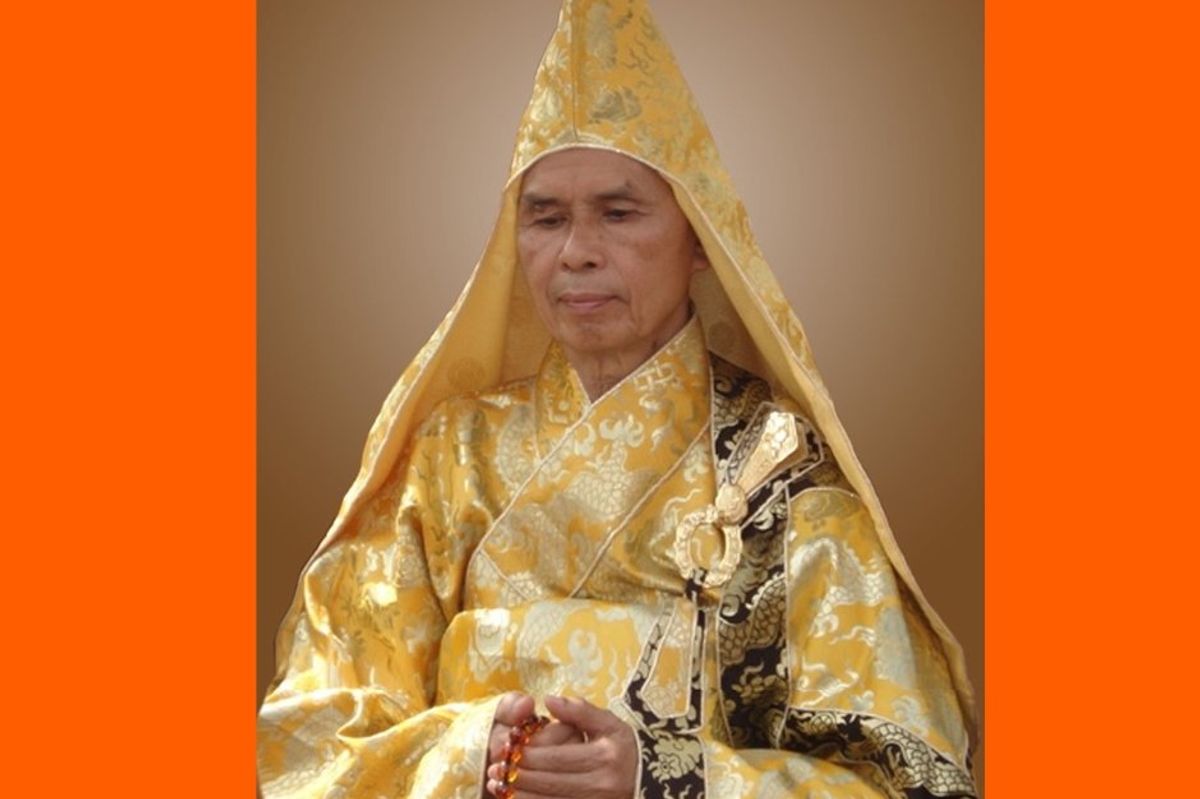Buddhist monk Thích Nhất Hạnh eases a child's grief with just eight words
"Birth and death are only a game of hide-and-seek."

Thích Nhất Hạnh was the forty-second heir of the Linji school of Zen Buddhism in Vietnam
There are times when it seems no words can soothe the sadness following the death of a loved one. Whether you're a child just discovering grief or a fully grown adult with years of trials and tribulations behind you, grief can sneak up and feel insurmountable.
Buddhist monk Thích Nhất Hạnh was a spiritual leader and Zen philosopher, whom many referred to as "the father of mindfulness." Coining the idea of "Engaged Buddhism," his aim was to turn the concept of reflection into action.
From Harvard.edu: "Some observers may associate Buddhism, and especially Buddhist meditation, with turning inward away from the world. However, many argue that the Buddhist tradition, with its emphasis on seeing clearly into the nature of suffering and, thus, cultivating compassion, has a strong impetus for active involvement in the world’s struggles. This activist stream of Buddhism came to be called 'Engaged Buddhism'—Buddhism energetically engaged with social concerns."

Hạnh spent the entirety of his life meditating on and writing about nonviolent conflict resolution, love, death, compassion, and mindfulness—and then urging people around the world to take action to make impactful change. He connected people of all faiths through his writing, teaching engagements, and the founding of the Plum Village Monastery in the Dordogne, southern France near the city of Bordeaux. In all he did, Hạnh worked with the intent to encourage people to seek both inner and outer peace.
Proving he was also a powerful poet, in an Instagram reel making the rounds, Hạnh was once asked by a child how she can "stop being sad." In the video she says, "I had a doggy. And this doggy died and I was very sad." She turns to him, "So I don't know how to be not so sad." Gently, he responds, "Suppose you look up into the sky and you see a beautiful cloud. And you like the cloud so much."
The child looks at him intently, her eyes welling up with tears. He continues, "And suddenly the cloud is no longer there. And you think that the cloud has passed away. Where is my beloved cloud now? So if you have time to reflect, to look, you see that the cloud has not died. It has not passed away. The cloud has become the rain. And when you look at the rain, you see your cloud."
Her eyes remain bright with curiosity, as he says, "And when you drink your tea, mindfully, you can see the rain in your tea and you can see your cloud in your tea. And you can say, 'Hello, my cloud. I know you have not died. You are still alive in a new form.' So the doggy is the same. And if you look very deeply, you can see doggy in its new form."
The girl starts laughing and crying in what seems to be a very pure moment of understanding. "You are still alive in a new form" seemed to help transform her thoughts on change and death in just minutes.
Aubert Bastiat (@aubertbastiat) posted the Instagram clip, which is a snippet from the documentary Walk with Me about Thích Nhất Hạnh's teachings. Bastiat comments, in his own words, "Love doesn’t vanish, it simply transforms." This concept is backed up in much of Hanh's work, including his book, No Death, No Fear: Comforting Wisdom for Life, in which he wrote, "Birth and death are only a door through which we go in and out. Birth and death are only a game of hide-and-seek. So smile to me and take my hand and wave good-bye. Tomorrow we shall meet again or even before."
Thích Nhất Hạnh, Buddhism, death, Buddhist monk www.youtube.com, Plum Village
And just under the first comment on the reel, the director of the documentary, Marc J. Francis, writes, "I shot this for my film Walk With Me…. Love seeing this scene being shared."
Something about the deep need to make sense of death spawned many vulnerable comments. People shared their heartfelt stories—from those who have lost someone recently to those who are sick and facing their own mortality.
And of Thích Nhất Hạnh himself, a commenter simply writes, "One of my life’s best teachers."



 Worried mother and children during the Great Depression era. Photo by Dorthea Lange via Library of Congress
Worried mother and children during the Great Depression era. Photo by Dorthea Lange via Library of Congress  A mother reflects with her children during the Great Depression. Photo by Dorthea Lange via Library of Congress
A mother reflects with her children during the Great Depression. Photo by Dorthea Lange via Library of Congress  Families on the move suffered enormous hardships during The Great Depression.Photo by Dorthea Lange via Library of Congress
Families on the move suffered enormous hardships during The Great Depression.Photo by Dorthea Lange via Library of Congress

 Millennial mom struggles to organize her son's room.Image via Canva/fotostorm
Millennial mom struggles to organize her son's room.Image via Canva/fotostorm Boomer grandparents have a video call with grandkids.Image via Canva/Tima Miroshnichenko
Boomer grandparents have a video call with grandkids.Image via Canva/Tima Miroshnichenko
 Classic Film GIF
Classic Film GIF  Oh nothing, just Edyth, Arthur, and Iris hanging out at the park.
Oh nothing, just Edyth, Arthur, and Iris hanging out at the park.
 It helps that Golden Retrievers are notoriously friendly. Photo by
It helps that Golden Retrievers are notoriously friendly. Photo by